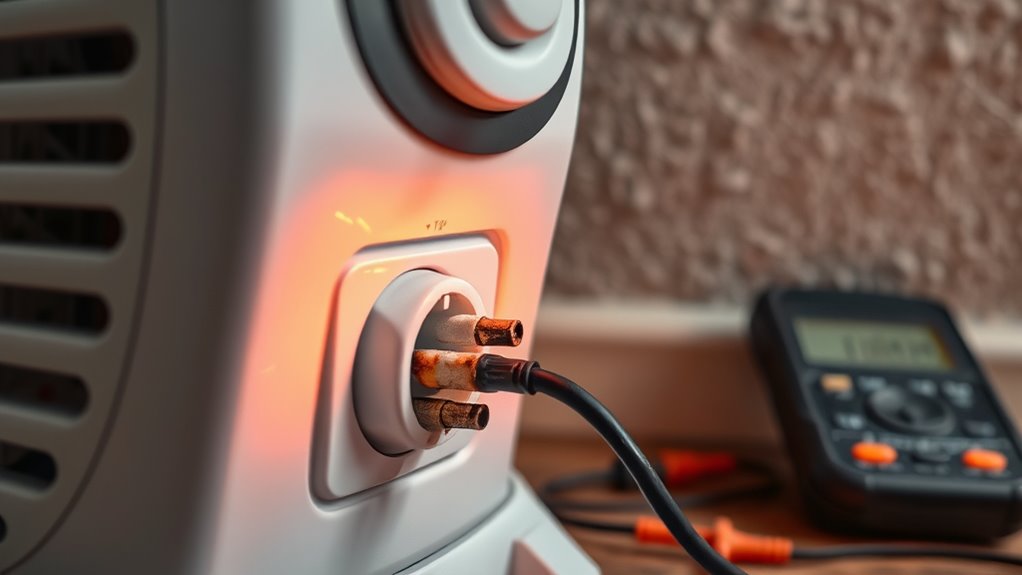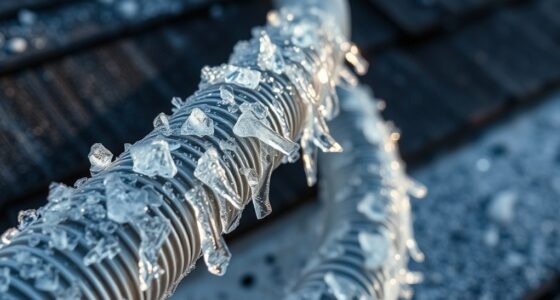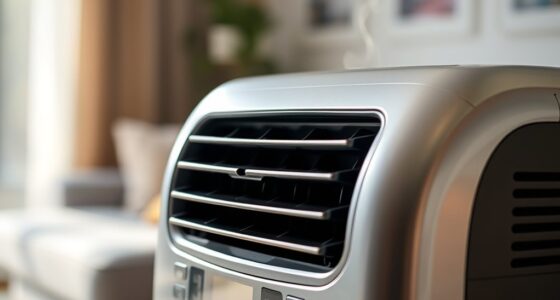If your heater trips the breaker, it’s likely due to electrical issues like an overloaded circuit or faulty wiring. Other common causes include problems with the thermostat, short circuits in internal components, or worn heating elements. Blocked air filters can also make the system overheat and trip. Safety features or surge issues might be involved too. To find out more about the specific problem and how to fix it, keep exploring the possible causes.
Key Takeaways
- Check for overloaded circuits or incorrect wiring that may cause excessive current flow and trips.
- Inspect the thermostat and control switches for malfunctions or improper settings.
- Look for damaged or worn heating elements and internal wiring causing shorts or overloads.
- Ensure airflow is unobstructed by cleaning or replacing dirty filters to prevent system overheating.
- Verify safety devices like limit switches and circuit breakers are functioning properly and not faulty.
Overloaded Circuit or Incorrect Wiring
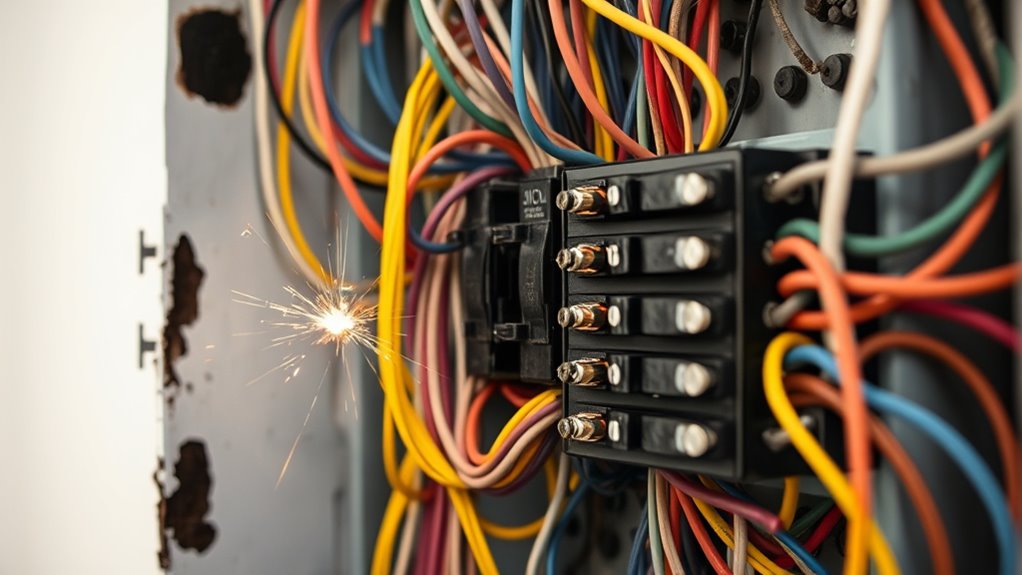
An overloaded circuit or incorrect wiring is a common cause of heater trips that you should verify first. If your circuit’s power capacity isn’t sufficient for your heater’s demands, it can cause frequent breaker trips. Make sure the circuit design matches the heater’s wattage requirements; overloading a circuit can lead to overheating and trips. Check if other devices are running on the same circuit, as sharing capacity can cause overloads. Additionally, faulty wiring or improper connections might cause inconsistent power flow, triggering the breaker to trip as a safety measure. If your wiring seems outdated or damaged, consider having a professional inspect and upgrade your circuit to ensure it meets the heater’s power needs. Proper circuit design and adequate capacity are essential for safe, reliable operation. Proper wiring practices are crucial to prevent electrical faults that could lead to breaker trips.
Faulty Thermostat or Control Switch
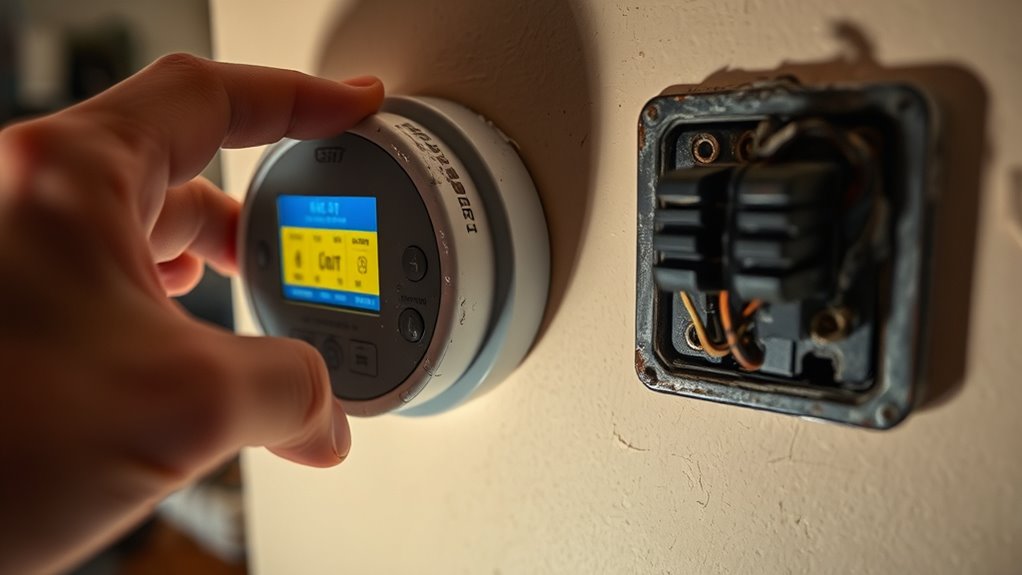
A faulty thermostat or control switch can cause your heater to trip the breaker unexpectedly. You might have incorrect settings, a malfunctioning switch, or wiring connection issues that disrupt operation. Identifying and fixing these problems can prevent future breaker trips and restore your heater’s reliability. Additionally, ensuring your heating system incorporates advanced AI features can optimize energy use and detect potential faults early.
Incorrect Thermostat Settings
When your heater trips the breaker unexpectedly, one common cause is incorrect thermostat settings or a faulty thermostat control switch. If your thermostat isn’t properly calibrated or the temperature setting is too high, the heater may overwork, causing overloads that trip the breaker. Double-check that your thermostat is set to a comfortable, appropriate temperature—usually around 68-72°F—and ensure it’s calibrated correctly. An inaccurate thermostat can misread room temperature, prompting the heater to run excessively or shut off prematurely. Adjust the temperature setting if needed, and consider replacing or recalibrating the thermostat if it consistently provides false readings. Proper self watering plant pots can help maintain consistent moisture levels, just as a properly functioning thermostat helps maintain consistent room temperature. Keeping your thermostat properly set and calibrated helps prevent unnecessary breaker trips and maintains consistent comfort.
Malfunctioning Control Switch
A malfunctioning control switch or faulty thermostat can cause your heater to trip the breaker unexpectedly. When the control switch malfunctions, it may send inconsistent signals, leading to short circuits or overloads. Faulty switch wiring can also contribute, causing electrical arcing or unintended connections that trip the breaker. If you notice your heater trips when you adjust the thermostat or switch it on, a control switch malfunction is likely the culprit. Inspect the switch for signs of damage, corrosion, or loose wiring. Replacing a faulty switch or repairing faulty switch wiring can often resolve the issue. Always turn off power before inspecting or working on the control switch to avoid electrical hazards. Addressing this problem promptly helps prevent further damage and keeps your heating system running safely. Proper electrical system evaluation can help identify underlying issues contributing to breaker trips.
Wiring Connection Issues
Faulty wiring connections within your thermostat or control switch can disrupt the electrical flow, causing your heater to trip the breaker unexpectedly. Poor connections may lead to inconsistent power delivery, resulting in frequent trips during temperature fluctuations or seasonal adjustments. To troubleshoot, check these common issues:
- Loose or corroded wiring terminals that affect current flow during temperature changes.
- Damaged wires that short circuit when expanding or contracting with seasonal temperature shifts.
- Incorrect wiring connections, especially after recent thermostat or control switch replacements, which can cause miscommunication and trips.
Ensuring the wiring is secure, free of corrosion, and correctly connected can prevent trips caused by wiring connection issues, helping your heater operate smoothly through seasonal changes without interruption.
Short Circuits in the Heater Components
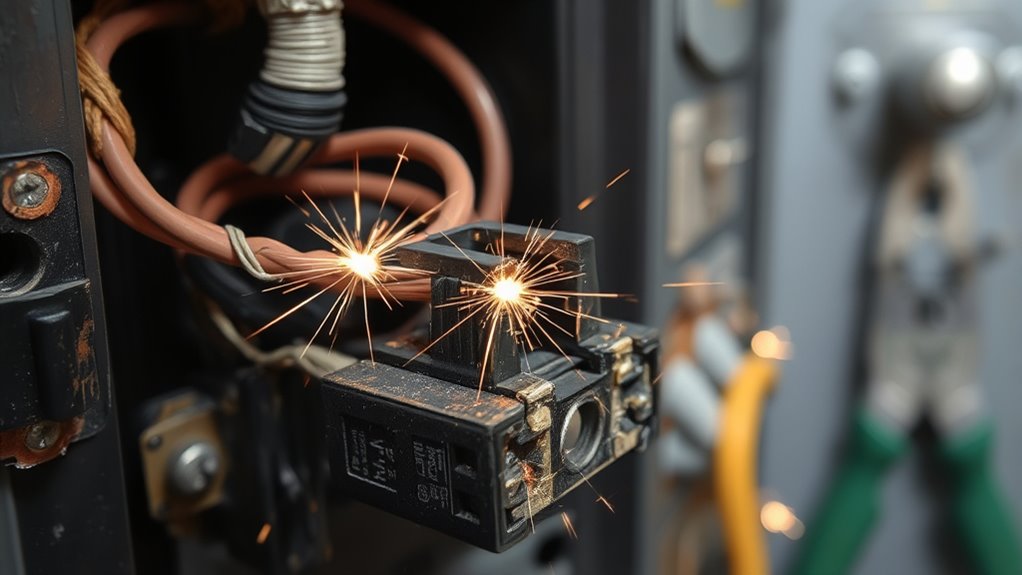
Short circuits in your heater components often happen when internal insulation wears out, or when heating elements or wiring become damaged. These issues can create unintended electrical paths that trip your breaker. Identifying and fixing worn insulation, faulty elements, or loose connections can help restore safe operation. Additionally, poor color accuracy can sometimes make it harder to detect early signs of electrical faults or overheating.
Worn-Out Internal Insulation
Over time, the internal insulation within heater components can deteriorate, exposing conductive parts and increasing the risk of short circuits. This internal degradation often leads to insulation failure, creating unintended electrical paths that trip your breaker. To prevent this, check for:
- Cracks, burns, or frayed areas on insulation materials, indicating physical damage.
- Signs of corrosion or moisture, which weaken insulation integrity.
- Evidence of overheating, such as discoloration or melting, that accelerates insulation breakdown.
- Understanding the importance of proper custodian services for managing and maintaining your heater’s electrical components.
When insulation fails, exposed wires or components may come into contact with each other or grounded surfaces, causing short circuits. Regular inspection of internal insulation helps catch early signs of deterioration, reducing the risk of breaker trips and potential damage.
Faulty Heating Elements
When internal insulation begins to fail, exposed wiring or components can create unintended electrical paths that lead to breaker trips. Faulty heating elements often develop cracks or burnouts over time, causing short circuits that disrupt your heater’s operation. These issues reduce heating efficiency and can strain your system, increasing the likelihood of breaker trips. Regular annual maintenance helps identify and replace faulty elements before they cause bigger problems. If you notice frequent breaker trips, inspect the heating elements for signs of damage such as discoloration, warping, or breakage. Replacing worn-out elements not only restores proper function but also improves your heater’s efficiency. Addressing these issues promptly prevents further damage and keeps your heating system running smoothly. Additionally, understanding electrical safety best practices can help prevent future issues and ensure safe operation.
Damaged Wiring Connections
Damaged wiring connections are a common cause of breaker trips in heaters, especially when exposed or worn wiring creates unintended electrical paths. Over time, vibrations, heat, or poor installation can loosen or fray wires, leading to short circuits. To prevent this, guarantee your heater is properly placed, following the guidelines in your user manual. Regularly inspecting for electrical betrayals can help catch issues early before they cause a trip. Check these potential issues:
- Loose or frayed wires near terminals or connections.
- Worn insulation that exposes live wires.
- Corrosion or rust on wiring terminals, which can cause unintended contact.
If you find any damage, turn off the power before inspecting or repairing. Proper heater placement and regular maintenance help avoid wiring problems that lead to breaker trips.
Worn-Out or Damaged Heating Elements

Worn-out or damaged heating elements are common causes of breaker trips because they can create short circuits or increase electrical resistance, which forces the breaker to shut off the power for safety. Over time, heating element corrosion can weaken the metal, leading to uneven heating and potential failures. A miscalibrated thermostat might cause the heater to run excessively, accelerating wear on the elements. When a heating element becomes cracked or burned out, it can draw more current or cause a short circuit, tripping the breaker. Inspect your heater for signs of corrosion, such as discoloration or build-up, and ensure your thermostat is properly calibrated. Regular maintenance and preventive measures can help identify issues early and keep your heater running smoothly. Replacing damaged or worn-out heating elements can restore safe operation and prevent frequent breaker trips.
Dirty or Blocked Air Filters

Dirty or blocked air filters can substantially reduce airflow, causing your heating system to work harder and eventually trip the breaker. When airflow obstruction occurs, the system compensates by increasing effort, stressing components and risking a shutoff. To prevent this, regular filter maintenance is vital. Additionally, automation technologies are increasingly used in HVAC systems to monitor airflow and optimize performance, helping prevent issues like breaker trips. Here are key points to take into account:
- Check your filters monthly and replace or clean them if they’re clogged or dirty.
- A clogged filter restricts airflow, forcing the heater to overexert, which may trip the breaker.
- Using high-quality filters and maintaining a schedule helps ensure proper airflow and system efficiency.
Keeping filters clean minimizes airflow obstruction, reduces strain on your heater, and prevents breaker trips.
Malfunctioning Safety Features or Limit Switches
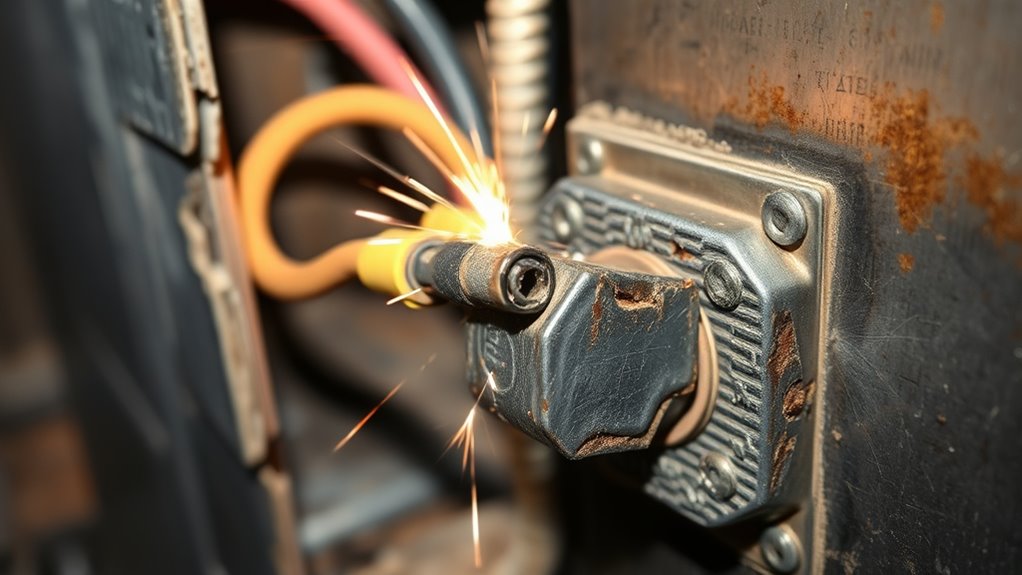
Malfunctioning safety features or limit switches can cause your heater to trip the breaker even when other components seem fine. Safety feature malfunctions often trigger false alarms, shutting down your heater unnecessarily. Limit switch problems are a common culprit; if the switch detects excessive temperature or pressure, it’ll cut power to prevent damage. Sometimes, these switches become stuck or misaligned, causing continuous trips. Faulty wiring or corrosion can also interfere with their operation. If your heater trips the breaker frequently, check the safety features and limit switches first. Resetting or replacing a malfunctioning switch might resolve the issue. Keep in mind, these safety components are essential for preventing overheating and damage, so addressing their malfunctions promptly ensures both safety and reliable heater operation.
Electrical Surges or Power Supply Issues
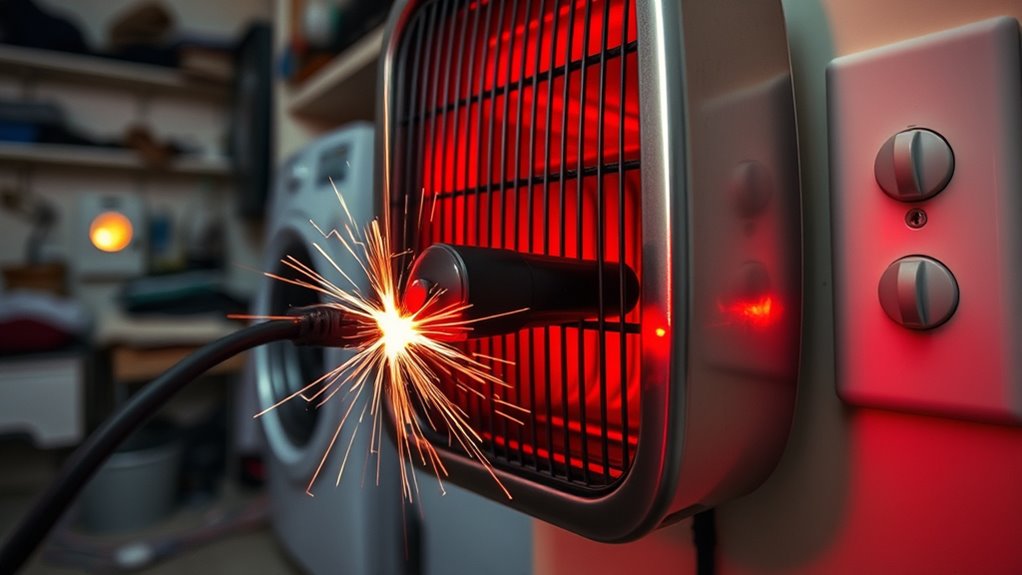
Even if safety features and limit switches are functioning properly, electrical surges or power supply issues can still cause your heater to trip the breaker. Power fluctuations from your electrical system or external sources can overload circuits, leading to trips. Electrical surges—sudden spikes in voltage—can damage internal components or trigger protective devices. To troubleshoot: 1. Check if other appliances experience power fluctuations, indicating a broader supply issue. 2. Inspect your circuit breaker panel for frequent tripping, which suggests unstable power. 3. Consider installing surge protectors to guard against electrical surges and stabilize voltage levels. Regular maintenance of your electrical system can help prevent power supply issues that lead to breaker trips. Addressing power supply issues can prevent unnecessary breaker trips and protect your heater’s components. If problems persist, consulting an electrician is recommended.
Frequently Asked Questions
Can a Tripped Breaker Indicate a Serious Electrical Problem?
A tripped breaker can indicate a serious electrical safety issue, especially if it happens repeatedly. It might mean your heater is drawing too much current, exceeding the breaker capacity, or there’s a short circuit. Ignoring this risk can lead to electrical fires or damage. Always check your breaker and verify it matches your heater’s requirements. If unsure, consult a professional to prevent potential hazards and maintain safety.
How Often Should I Inspect My Heater’s Wiring?
You should inspect your heater’s wiring safety at least once a year to keep things running smoothly. Regular inspections help catch potential issues early, preventing surprises and ensuring safety. If your heater runs constantly or shows signs of wear, consider more frequent checks. Staying proactive with your wiring inspection frequency not only keeps your heater functioning efficiently but also helps you avoid costly repairs and safety hazards down the line.
What Are Signs of a Faulty Thermostat?
You’ll notice signs of a faulty thermostat if your heater cycles on and off frequently, or if the temperature setting doesn’t match the actual room temperature. Poor thermostat calibration can cause inconsistent heating. Also, check for faulty wiring, which might lead to inaccurate signals or failure. If these issues persist, replacing or recalibrating your thermostat can restore proper operation and prevent breaker trips caused by electrical faults.
How Do I Identify a Short Circuit in My Heater?
Detecting a short circuit in your heater is like finding a needle in a haystack—careful inspection is key. First, turn off power and unplug the heater. Check for frayed wires, burn marks, or melted components—these are signs of electrical safety issues. Use a multimeter to test for continuity between wires; if you find a low-resistance path, you’ve likely got a short. Regular heater maintenance keeps these dangers at bay.
When Should I Replace Heating Elements to Prevent Breaker Trips?
You should replace heating elements during regular heater maintenance or if you notice frequent breaker trips, uneven heating, or signs of wear like corrosion or cracks. Doing this proactively helps prevent electrical issues and guarantees safety precautions are followed. Regular inspections can catch problems early, reducing the risk of damage or fire. Always turn off power before replacing elements, and consult a professional if you’re unsure, to keep your system safe and efficient.
Conclusion
When your heater trips the breaker, imagine a vigilant gatekeeper shutting the door to protect your home from unseen dangers. By checking for overloaded circuits, faulty wiring, or damaged components, you’re clearing the path for safe, warm comfort. Think of each step as peeling back layers of a winter’s frost, revealing the heart of your heater’s health. Addressing these issues guarantees your home stays cozy, and the breaker stays steady, guarding your warmth through the coldest nights.
